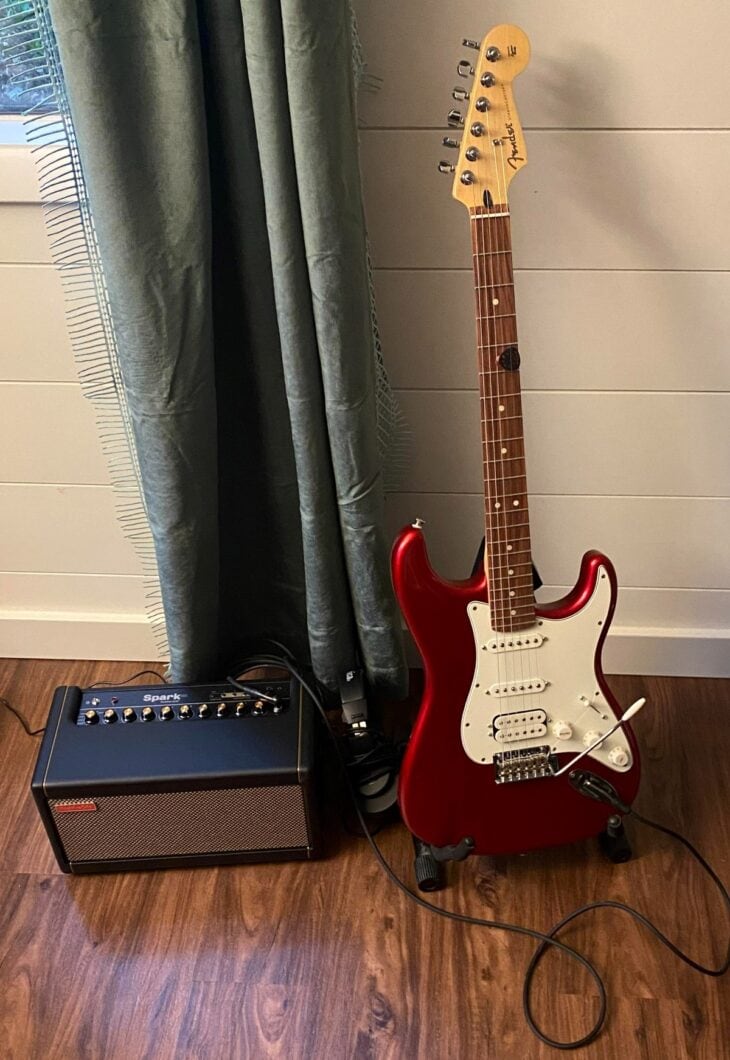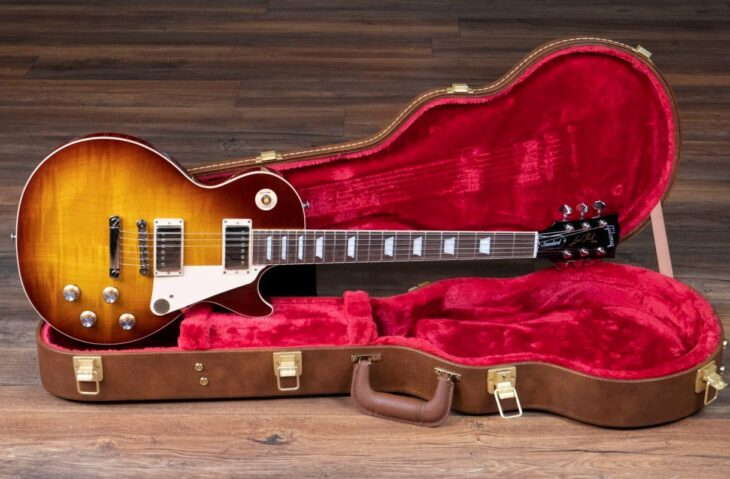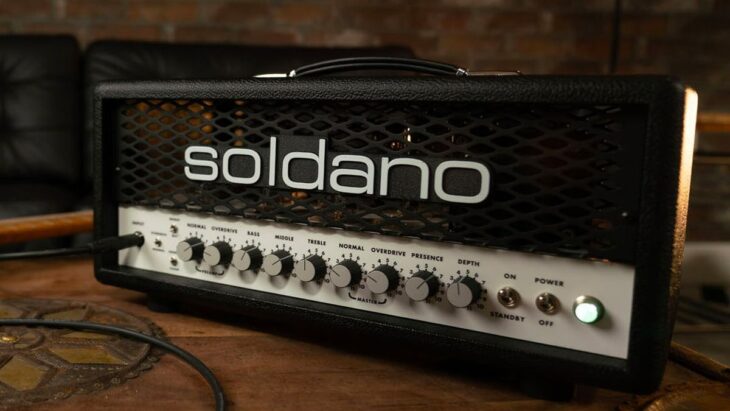Few guitar players in history can hold the badge that Mark holds: You can recognize him with one note. Since he owns such a personal (and worldwide famous) guitar tone, many players, including me, have been trying to nail the sound for years (some of us for decades).
In this piece, you’ll find the guitars (with cheaper alternatives), effects, and amps that made Mark a legend in the guitar world. Plus, I’ll add some amp settings so you can fine-tune your rig to match Mark’s uncanny tone.
Are you ready? Well, put on that turban, Sultan, because it’s swing time!
Table of Contents
Mark Knopfler Guitars

Mark Knopfler’s taste changed a lot during his musical career. Perhaps, watching his vast (and amazing) guitar collection, you can find opposite guitar tones. Well, from that tonal juxtaposition, Mark made magic happen.
But let’s rewind for a bit to the moment it all started. Mark was born in Glasgow, Scotland in 1949. At a young age, he was a fan of The Shadows, and drooling all over Hank Marvin’s red Stratocaster. His parents couldn’t afford one, so he got started with a 1962 Hofner Super Solid. This is a guitar he still owns to this day.
Nevertheless, as his fame grew as a guitar player, he was eventually able to pay for a red Stratocaster and his 1960/61 Fiesta Red Stratocaster is, perhaps, his most memorable guitar.
He went through many Stratocasters in his life including various Schecter models like the Dream Machine (sunburst with a brass pickguard), a candy apple red Schecter, and even a Schecter model put together by John Suhr with a Fender decal on the headstock!
The signature guitar that Fender made for Mark is currently discontinued, but you can get very close with a Fender American Vintage II 1961 Stratocaster. Which comes in Mark-approved Fiesta Red.
For a smaller budget, you can also get a Fender Vintera II ’60s Stratocaster or a Squier Classic Vibe ’60s Stratocaster. For that quintessential maple-neck tone he had in the mid-to-late ‘80s, you can go for the same models above but their ‘50s versions.

Speaking of red Fenders, Mark also played a red Schecter Telecaster that’s very close to a Custom Telecaster from the ‘60s (with that beautiful double binding on the body). You can get close with a Fender American Vintage II 1963 Telecaster, a Fender Vintera II ’60s Telecaster, or a Squier Classic Vibe 60’s Telecaster Custom.
Right around the mid-80s, Mark got his hands on a 1984 Gibson Les Paul ’59 Reissue. This was a high-quality recreation of Gibson’s Holy Grail. These guitars are what you would call “prehistoric” because they’re older than the new “Historic” collection of reissues.
Although that guitar is not on the market, you can have your way with the bombastic Gibson Custom 1959 Les Paul and the Gibson Custom 1958 Les Paul. These guitars are recreations but Mark owns an original ’59 and an original ’58 Les Paul as well.
For a more moderate budget, you can also get a Gibson Les Paul Standard ’50s, or make a move into the Epiphone realm with the Epiphone Limited Edition 1959 Les Paul or the Epiphone Les Paul Standard ’60s.

Let me tell you that those three guitar models cover pretty much all the early years of Mark’s career. That was until he got together with long-time friend Rudy Pensa, a New York-based Argentinian luthier. Together, they designed Mark’s new guitar, one you must have seen a million times, the Pensa MK.
At the time, when they built the first one, it wasn’t made by Rudy, but by legend John Suhr, who was a repairman at Rudy’s at the time. The guitar is so close to the PRS Gibson-meets-Fender formula that it’s hard to think it’s a coincidence.
It features a mahogany body with a carved maple top, a Brazilian Rosewood fingerboard, an EMG 81 humbucker in the bridge, and dual SA single coils. The controls include a volume knob and a tone knob that also works as a gain booster. Finally, the guitar stays perfectly in tune thanks to a set of Sperzel tuners and a Floyd Rose (single action) locking tremolo.
Later on, Rudy Pensa put out a series of MK guitars. These were no longer made by John Suhr (who founded his own, utterly successful company) but by Rudy himself. The guitars feature a mahogany body with a flame koa top and 3 Lindy Fralin single-coil pickups.
Although Pensa guitars are rare and hard to find, a Jackson USA Signature Phil Collen PC1 could be a good replacement. If your budget isn’t that bulky, the Jackson Pro Plus Series Soloist SLA3Q or a PRS SE Custom 24 Floyd might be good replacements.
Those are Mark’s most relevant electric guitars, but as you might imagine, he amassed quite a collection since the mid-60s.
Other relevant vintage guitars include:
- 1954 Stratocaster
- 1958 Les Paul
- 1959 Les Paul
- 1954 Fender Telecaster
- 1959 ES-336 TDL
- 1960 ES-330
- 1957 Gretsch 6120 Chet Atkins Country Gentleman
- 1963 Danelectro DC-1
- Danelectro Singletone
- 2008 Monteleone Isabella Guitar
- Pensa MKD with dual P-90s
As for acoustics, we’ll just list the most relevant ones:
- National Resonator
- Chet Atkins Solidbody Classic Guitar
- 1935 Martin D-18
- 1938 Gibson Advanced Jumbo (Brazilian rosewood back and sides)
- 1953 Gibson Southern Jumbo
- Martin Mark Knopfler Signature Guitar HD-40 MK
- Martin Mark Knopfler Signature Guitar 000 40-S
- Mini Martin (in Nashville tuning)
Mark Knopfler Effects Pedals
Mark Knopfler went through the ‘80s with the huge racks as everyone else did, but his guitar tone always remained super simple, direct, and beautiful.
What you need to achieve it, is a good delay pedal, which can be a Boss DD-3T or an MXR Carbon Copy for more warmth.
You also need a good reverb. If your amp has one, then never mind, if it doesn’t, a simple pedal like the TC Electronic Hall of Fame or the TC Electronic Skysurfer can do the trick just fine.
The gain stages in Mark’s sound are very subtle and he also uses a compressor for those clean, percussive lead tones. For those endeavors, I recommend an Ibanez TS9 Tube Screamer and an MXR Dyna Comp.

Finally, for that ultra-nasal tone in “Money for Nothing”, you need a Wah pedal to leave it fixed in the middle position. A Dunlop GCB-95 Cry Baby Wah pedal will do the trick just fine.
Mark Knopfler Amplifiers
We could boil down all the amplifiers Mark used throughout his career into three brands: Fender, Marshall, and Soldano.
Early in his career, Mark used an early sixties brown face 1×12 Vibrolux. He also used Twin Reverbs, which you could replace with a Deluxe Reverb or a more modest Fender Hot Rod Deluxe.

Also, Mark was known for using 4×10” configurations, such as the Fender Super Reverb.
If your budget can’t make it to those numbers, a Fender Blues Junior IV or a Bugera V22 Infinium can also do the trick. Or, for a choice with no amp, you can get the UAD Dream ’65 Pedal.
His Marshall tone is very defined, he used the quintessential Marshall amp, the one that started it all, the Marshall JTM45 2245. You could replace it with a more modern Marshall ST20H Studio JTM or a Marshall ORI20H. Or you can go amp-less with the UAFX Lion ’68 Super Lead Amp Pedal
Soldano amplifiers were the amp of choice of many ‘80s axemen like Clapton, for example. Their controls go all the way to 11 (reality beating fiction, Spinal Tap fans!) and they hold enough gain and power for arenas. Mark used the flagship model the SLO100.

If that 100-watt all-tube beast is too much for you, the Soldano SLO-30 is an option, and the tiny Soldano SLO Mini is another option. Beware though, these amps are not for the faint of heart.
Mark Knopfler Amp Settings
Now that you know all the amps he was using, let’s try and nail some tones. I’ll state the amp and guitar as well as the effects so you can have an idea of what to use.
But I also have a surprise for you. The image next is the actual control sheet Mark and his tech used for the “On Every Street” tour. I know, my pleasure, you’re more than welcome.
Sultans of Swing Amp Settings
Guitar: Maple-fretboard Fender Stratocaster
Amp: Fender
FX: Compressor and Reverb
- Gain – 6
- Volume – 5
- Bass – 9
- Middle – 5
- Treble – 5
- Presence – 7
Money for Nothing Amp Settings
Guitar: Gibson Les Paul
Amp: Marshall
FX: Overdrive, Reverb, Wah (in a fixed position)
- Gain – 4
- Volume – 7
- Bass – 9
- Middle – 8
- Treble – 3
- Presence – 6
Brothers in Arms Amp Settings
Guitar: Les Paul
Amp: Marshall
FX: Compressor, Reverb
- Gain – 5
- Volume – 7
- Bass – 9
- Middle – 9
- Treble – 5
- Presence – 6
So Far Away Amp Settings
Guitar: Pensa (Super Strat)
Amp: Fender
FX: Reverb, Delay, Overdrive
- Gain – 3
- Volume – 7
- Bass – 8
- Middle – 7
- Treble – 6
- Presence – 7
The Bottom End
We’ve seen the tools that this guitar legend used to create a sonic empire under his name. I’m not here to tell you that this gear will make you sound like him, but it can be a motivation or an inspiration to continue playing until you find your signature sound.
Remember, there are more chances to land on your style while failing to copy your idols than not playing.
Hopefully, I’ll be writing a piece like this about you in the near future!
Happy (fingerstyle) playing!

